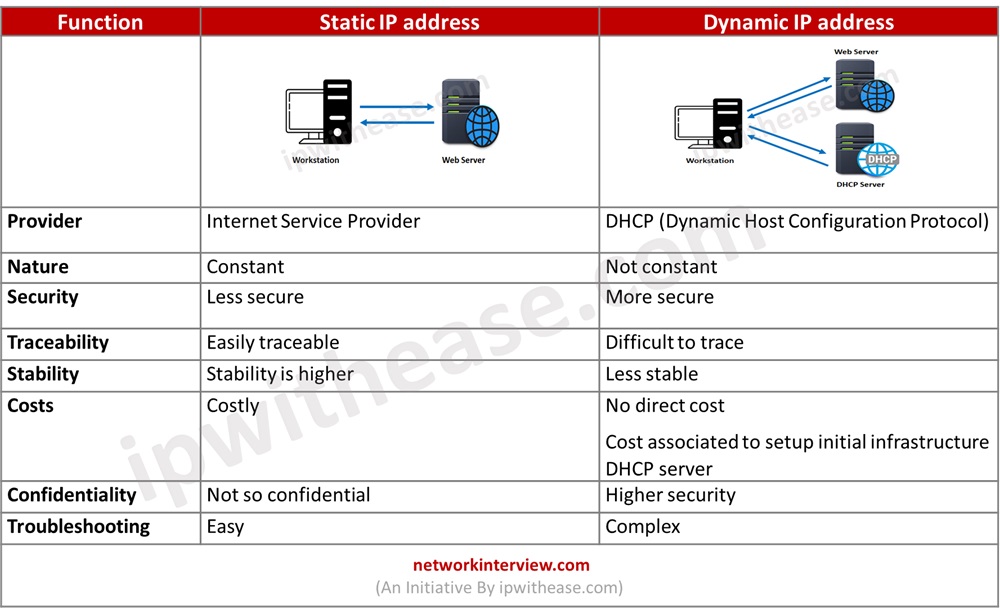
Static IP vs Dynamic IP Addresses: What is the difference?
All communication in Internet world is govern by OSI (Open Systems Interconnect) framework. There are seven layers in OSI model and each layer performs a set of functions to ensure data delivery to its intended recipient. The layer 3 or network layer is responsible for packet routing, forwarding across interconnected networks. This uses Internet protocol which uses a unique address to identify every host in the network referred as IP address. It is a numeric value assigned to a device and used for identifying the location of network devices.
Today we look more in detail about IP address and its types, how they function and the difference between them i.e. Static IP vs Dynamic IP Addresses.
What is Static IP Address?
IP address could be distinct having allotted to each device individually on a network. The word static means ‘fixed’ and ‘not change’. The static IP address refers to an IP address which is assigned to a device permanently and does not change. Static IP addresses are usually found on web servers. This is usually utilized by businesses which require to communicate globally and desire a fixed identity. Since they are finite and to be assigned individually, they entail monthly fees.
Use cases for Static IP addresses
- DNS – website managers use static IP addresses with DNS information which connects consistently using static address as it does not change
- Website hosting – with a static address assignment to website, it is easier for users to find them easily on Internet
- Voice communications – Voice over IP works better with consistent connections
- Remote access – consistent connections between remote works and organization networks is possible with static IP addresses
- Geolocation reliability – services rely on static IP addresses for geolocation capabilities such as weather or traffic updates
- IP Allowlisting – Remote workers having static IP address help security teams to filter legitimate traffic to promote better data security.
What is Dynamic IP Address?
IP address often changes when user reboots the system and its allocated mechanically. Dynamic IP addresses changes every time device connects to Internet. It does not entail cost to use dynamic IP address. ISP servers assign them as required. These are standard identifiers for consumer devices and mostly used in home networks for identification of tablets, laptops, and digital devices such as box.
Use cases for Dynamic IP address
- Used in home settings and consumer settings
- Used by mobile devices such as tablets and smartphones
Static IP vs Dynamic IP Addresses: Differences
Key points of comparison between the two types of IP addresses are:
Provider:
Internet service provider provides static IP addresses whereas Dynamic IP address is provided by DHCP (Dynamic host configuration protocol) server.
Nature:
Static IP address is constant and do not change any time. Dynamic IP address is not constant in nature and can change multiple times.
Security:
Since Static IP address is static in nature it is easy to intercept hence less secure. Dynamic IP addresses are more secure as they are difficult to intercept as they keep changing.
Traceability:
Devices assigned static IP addresses are easily traceable. Dynamic IP assignment makes difficult to trace a device to which it is assigned.
Stability:
Stability is higher in static IP address whereas Dynamic IP addresses are less stable.
Costs:
Static IP addresses are costly and provided by ISPs at high charges. Dynamic IP addresses itself do not entail cost, but there could be cost associated to setup initial infrastructure DHCP server etc.
Confidentiality:
If the requirement is that data is not so confidential but service reliability and availability is of concern then static IP addresses are being used such as servers hosting business applications. If the requirement is of higher security and lesser costs then dynamic IP address allocation is preferred such as endpoint systems.
Troubleshooting:
Troubleshooting is easier for static IP address as IP is fixed. Troubleshooting is complex and difficult to diagnose network issues as IP address assignment is not fixed.
Static IP vs Dynamic IP Addresses: Comparison Table
Below table summarizes the differences between Static and Dynamic IP address:

Download the comparison table: Static IP vs Dynamic IP
Continue Reading:
IP Address Restrictions for Improved Access Control
NAT vs PAT: IP Address Translation Explained
Tag:comparison



